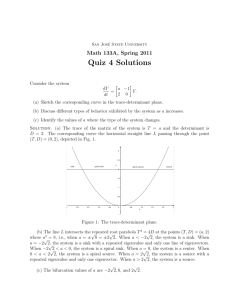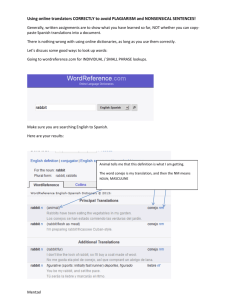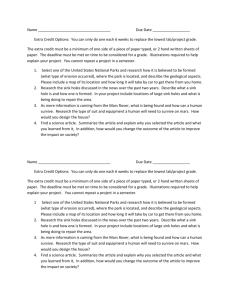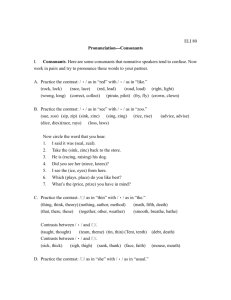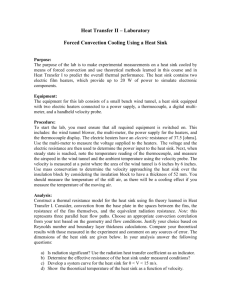Fastening Hardware for Heat Sink Assembly
advertisement
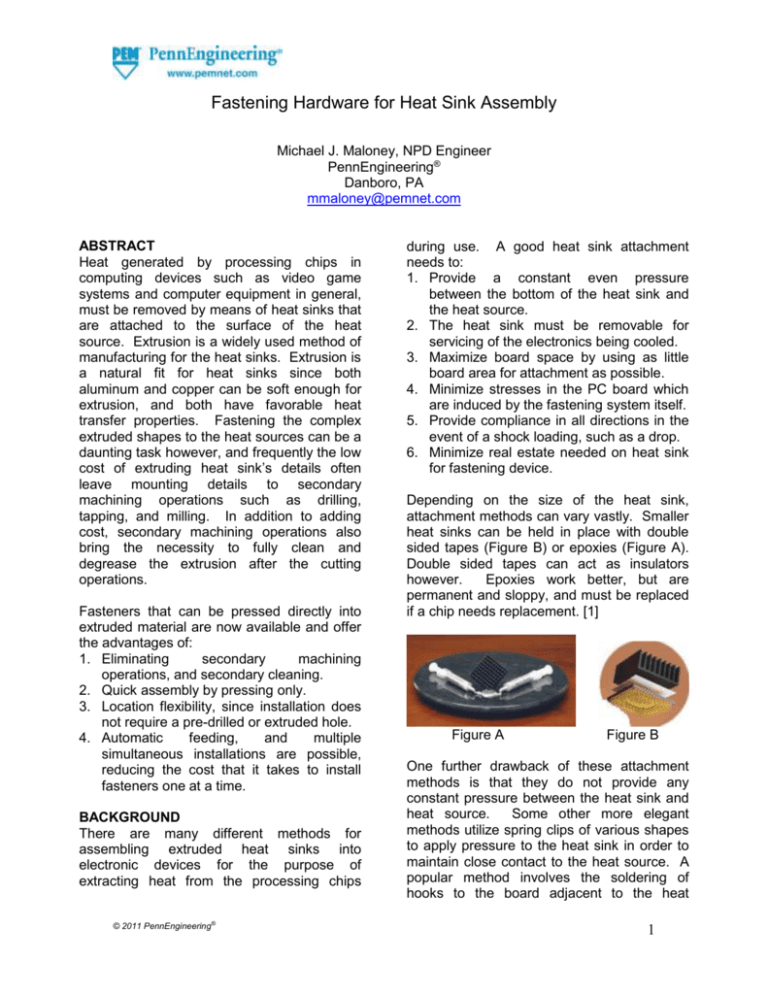
Fastening Hardware for Heat Sink Assembly Michael J. Maloney, NPD Engineer PennEngineering® Danboro, PA mmaloney@pemnet.com ABSTRACT Heat generated by processing chips in computing devices such as video game systems and computer equipment in general, must be removed by means of heat sinks that are attached to the surface of the heat source. Extrusion is a widely used method of manufacturing for the heat sinks. Extrusion is a natural fit for heat sinks since both aluminum and copper can be soft enough for extrusion, and both have favorable heat transfer properties. Fastening the complex extruded shapes to the heat sources can be a daunting task however, and frequently the low cost of extruding heat sink’s details often leave mounting details to secondary machining operations such as drilling, tapping, and milling. In addition to adding cost, secondary machining operations also bring the necessity to fully clean and degrease the extrusion after the cutting operations. Fasteners that can be pressed directly into extruded material are now available and offer the advantages of: 1. Eliminating secondary machining operations, and secondary cleaning. 2. Quick assembly by pressing only. 3. Location flexibility, since installation does not require a pre-drilled or extruded hole. 4. Automatic feeding, and multiple simultaneous installations are possible, reducing the cost that it takes to install fasteners one at a time. BACKGROUND There are many different methods for assembling extruded heat sinks into electronic devices for the purpose of extracting heat from the processing chips © 2011 PennEngineering® during use. A good heat sink attachment needs to: 1. Provide a constant even pressure between the bottom of the heat sink and the heat source. 2. The heat sink must be removable for servicing of the electronics being cooled. 3. Maximize board space by using as little board area for attachment as possible. 4. Minimize stresses in the PC board which are induced by the fastening system itself. 5. Provide compliance in all directions in the event of a shock loading, such as a drop. 6. Minimize real estate needed on heat sink for fastening device. Depending on the size of the heat sink, attachment methods can vary vastly. Smaller heat sinks can be held in place with double sided tapes (Figure B) or epoxies (Figure A). Double sided tapes can act as insulators however. Epoxies work better, but are permanent and sloppy, and must be replaced if a chip needs replacement. [1] Figure A Figure B One further drawback of these attachment methods is that they do not provide any constant pressure between the heat sink and heat source. Some other more elegant methods utilize spring clips of various shapes to apply pressure to the heat sink in order to maintain close contact to the heat source. A popular method involves the soldering of hooks to the board adjacent to the heat 1 Fastening Hardware for Heat Sink Assembly source (chip being cooled). A bent wire spring is then clipped across the hooks and over the heat sink to hold it in place (Figure C). Others use a plastic bracket to clip onto the heat source, to which a spring is then clipped. (Figure D) These methods are fine if the heat sink is not too heavy since the force that can be applied this way is limited to the strength of the PC board, or the plastic clip. [1] Figure C Figure D Heavier heat sinks that require greater force to hold them in place need to consider board stresses that will be induced by the attachment method. Bending stresses induced into the circuit board can cause costly fracturing of electrical traces, and even failure of components, or their connections to the board. To handle heavier heat sinks, fasteners with springs that control the load applied are frequently used. One style is simply a shoulder screw with a spring around it that passes through the heat sink and compresses the spring onto the top of the heat sink by a prescribed amount (Figure E). The stud is tightened into a nut on the opposite side of the board. Another style incorporates a snap top feature on the stud instead of a screw thread. The snap portion of the stud is pushed through a hole in the PC board. [1] © 2011 PennEngineering® Figure E These stud and spring type of fasteners are also useful in mounting shallow heat pipes / heat sinks into laptop computers where space is a constraint. Oddly shaped heat pipes can have stud and screw mounting points at various locations along the heat pipe, and ensure that a solid, even contact is achieved where necessary. The photo below (Figure F) illustrates such a heat pipe. The heat source and PC board would be sandwiched between the two sections joined by the studs and springs in the photo. There is a cost for this effective solution. The hardware used with these springs and studs is both costly and cumbersome, when the necessary customization and complex assembly of the fasteners is considered. Figure F While the springs and studs method can control the stresses induced in the PC board they do not completely eliminate them. Another method which utilizes four studs and an “X” shaped spring, accomplishes the task of even loading between the heat sink and heat source, with the addition of only one compression load directly between the heat sink and directly beneath the heat source (Figure G). The “X” shaped spring has a fulcrum at the intersection of the “X” which pushes directly beneath the chip being cooled. The ends of the spring pull down on each of four studs in the heat sink beneath the PC board. The photos below illustrate this. 2 Fastening Hardware for Heat Sink Assembly geometry being extruded into the heat sink, as such it lacks flexibility. PEM® SOLUTIONS Figure G PennEngineering® has some unique cost saving solutions to these fastening problems. The “Spinning Clinch Bolt” is a screw which is captivated into a host material when pressed into a punched or drilled hole. The screw is free to turn and has vertical float in a neck area. A new version of this screw has a shoulder which captivates and centers a spring, which can provide a predefined pressing force onto the host / heat sink. The photos below detail this solution (Figure I). Frequently a heat sensing device is attached to a heat sink to add a level of control which can adjust cooling fan speed, or shut the device down prior to catastrophic failure. The photo below (Figure H) illustrates such a device and two methods of attachment. [2] Figure H Figure I On one of the heat sinks, a hole is drilled and tapped for the attachment of the heat sensor (voltage regulator). On the other, a clip is used which is cleaner and faster than a screw. The clip does have downside however, in that it depends upon the proper © 2011 PennEngineering® The top rendering illustrates a hypothetical heat sink being held in place with four spinning clinch bolts with springs. A section of one of the bolts is shown in the second photo. This photo shows how the screw is 3 Fastening Hardware for Heat Sink Assembly retained by heat sink material that has flowed to the neck diameter. The screw bottoms out in a stand off fastener designed for use in tension, that is installed in a backing plate beneath the PC board. This configuration creates even loading of the heat sink with a predefined force at all four corners being supplied by the compressed springs on the screws. The resultant assembly reduces the hardware and overall costs that are required for typical stud and spring attachments. of the heat sink being attached. The primary advantage of this type of hardware is the elimination of the necessary secondary operations for the attachment of mounting hardware, that is to say, no drilling, tapping, and cleaning of the extrusion, just to attach the hardware. The photo below (Figure K) shows a cross section of the embedding portion of an installed part. The photo below (Figure J) is an example of an assembly which uses five pieces of hardware that could be replaced with a spinning clinch bolt with a spring and a standoff in a backer plate, or a surface mount nut if the backer plate is not required. C B A Figure K The leading edge of this part cuts into the surface of the heat sink. The shank (A) portion is knurled to prevent rotation, and an undercut (B) above the knurls is filled by a flat displacer to prevent pull out. This fastener is installed by pressing on the shoulder (C) above the embedding features. Pull out performance for the M2.5 fastener shown, with 1.3 mm penetration, from extruded aluminum, is around 200 lb. (890 N). Figure J PEM®S.E.T.™ HARDWARE PEM®S.E.T.™ stands for PEM® Surface Embedding Technology. These types of fasteners are pressed directly into the surface © 2011 PennEngineering® PEM®S.E.T.™ hardware can be used to install studs in the base of a heat sink. Because no installation hole is required, costs associated with the drilling and tapping and cleaning of the mounting holes are eliminated. Since the fasteners do not require turning to be installed, tooling can be made to accommodate multiple installations in one pressing, significantly reducing the installed cost of the fasteners. 4 Fastening Hardware for Heat Sink Assembly PEM®S.E.T.™ technology can also be used for assembling sensing devices to heat sinks, with a tack type fastener as is shown in the photos below. (Figure L) Figure M The photos below (Figure N) illustrates how this fastener is installed into a sunflower type of extrusion, and further used to assemble a fan to the heat sink, and the entire unit to a heat source on a PC board. Figure L STAMPED HARDWARE The photos that follow at the top of the right column illustrate how a fastener can be made by assembling two stamped (or some other process that can make cut a flat profile) components. The pictured fastener incorporates a clinching feature that enables the fastener to be captivated into a sunflower type of extruded heat sink (Figure M). The top of the fastener is a snap top feature that mounts the cooling fan and provides both a positive locking feature and a downward force feature to attach the fan to the extrusion. Finally the bottom feature incorporates another snapping feature for the connection of a custom “X” shaped spring or pressure plate. © 2011 PennEngineering® Figure N 5 Fastening Hardware for Heat Sink Assembly This stamped part effectively combines 8 pieces of hardware into 4, and eliminates costly tapping and cleaning operations, as well as reducing assembly operations. It is easy to see how this solution can save cost. CONCLUSION There are many existing options to meet the requirements of an effective heat sink fastening system. Available solutions for larger heat sinks often involve hardware requiring threaded sections in the extruded portion. Secondary machining operations add cost for the machining itself, and subsequent cleaning of chips. Solutions from PennEngineering®, employ self captivating methods including clinching and PEM®S.E.T.™ styles to both reduce the amount of hardware necessary for attachment, and also the secondary machining operations necessary to make threads for standard hardware. REFERENCES: 1. Advanced Thermal Solutions, Heat Sink Attachment Options, Photos, July 2008 http://www.qats.com/Products/HeatSinks/1.aspx 2. Aavid Thermalloy: Photos www.aavidthermalloy.com/ © 2011 PennEngineering® 6


